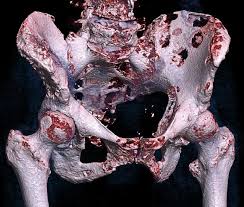
Scientists at Aston University may have discovered a potential cure for bone cancer, also known as osteosarcoma.
This rare and aggressive type of cancer affects approximately three to five people per million and has a high rate of metastases and recurrence, with survival rates drastically reduced for patients who experience cancer recurrence.
Bone cancer commonly arises in two distinct age groups: adolescents and adults aged 65 and above. This aggressive disease is marked by the presence of immature bone osteoid and arises from bone-producing mesenchymal cells.
Osteosarcoma usually develops towards the end of long bones, and it is reported to have a high rate of metastases and recurrence and is difficult to treat. Osteosarcoma patients who have developed distant metastases were reported to have a five-year survival rate of less than 30% and this makes osteosarcoma with distant metastases like lung metastases one of the leading causes of death for osteosarcoma patients.
But scientists have developed a new treatment that combines tiny pieces of glass with a toxic metal, gallium, which has shown a 99% success rate in eliminating cancerous cells in recent lab tests.
This finding provides hope for more effective treatment options and better outcomes for those who have been diagnosed with this rare type of cancer.
The research team, led by Professor Richard Martin from the university’s College of Engineering and Physical Sciences, has developed a method that uses bioactive glass particles combined with gallium, a toxic metal, to eliminate cancerous cells.
In the conducted lab tests, the bioactive glass particles successfully destroyed 99% of osteosarcoma cells while leaving the non-cancerous human bone cells unharmed.
The glass particles also promoted bone regeneration in the early stages of testing, according to the research team.
“We believe that our findings could lead to a treatment that is more effective and localised, reducing side effects, and can even regenerate diseased bones,” Martin said.
The researchers explain that they used a simulated body fluid and after seven days, they detected the early stages of bone formation from the glass.
They added that their treatment method involved rapidly cooling molten liquids to form glass, which was then ground into tiny particles.
These particles, when combined with gallium, were shown to be highly effective in destroying cancer cells.
Survival rates are substantially reduced for patients who have a recurrence and primary bone cancer patients are also more susceptible to bone fractures, they added.
Meanwhile, Dr. Lucas Souza, research laboratory manager for the Dubrowsky Regenerative Medicine Laboratory at the Royal Orthopaedic Hospital in Birmingham, said the findings are really promising but noted the importance of further testing to ensure the safety and effectiveness of the biomaterials.
“The safety and effectiveness of these biomaterials will need to be tested further, but the initial results are really promising,” Dr Souza said.
Cancer remains the second leading cause of death globally, accounting for an estimated 9.6 million deaths, or 1 in 6 deaths, in 2018, according to the World Health Organisation (WHO)





